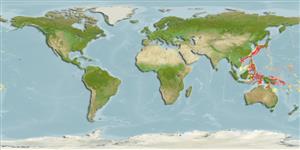Actinopterygii (Straalvinnigen) >
Ophidiiformes (Cusk eels) >
Bythitidae (Viviparous brotulas) > Bythitinae
Etymology: Cataetyx: Greek, kata = down + Greek, etix, stixo, stizo = to prick, to puncture.
Omgeving / Klimaat / Range
Ecologie
; marien bathydemersaal; diepteverspreiding 100 - 400 m (Ref. 559). Deep-water, preferred ?
Western Pacific: Japan and the Philippines.
Size / Gewicht / Leeftijd
Maturity: Lm ? range ? - ? cm
Max length : 13.0 cm SL mannelijk/geslacht niet bekend; (Ref. 559)
Korte beschrijving
Morfologie | Morfometrie
Dorsale stekels (totaal): 0; Dorsale zachte stralen (totaal): 75-81; Anale stekels 0; Anale zachte stralen: 49 - 56. Head with scales. Pseudobranches with 2 small filaments. Three gill rakers developed on 1st arch. Attains 13 cm SL.
Rare species (Ref. 34024). Taken in bottom trawls (Ref. 34024).
Life cycle and mating behavior
Geslachtsrijpheid | Voortplanting | Kuitschieten | Eieren | Fecundity | Larven
Nielsen, J.G., D.M. Cohen, D.F. Markle and C.R. Robins, 1999. Ophidiiform fishes of the world (Order Ophidiiformes). An annotated and illustrated catalogue of pearlfishes, cusk-eels, brotulas and other ophidiiform fishes known to date. FAO Fish. Synop. 125(18):178p. Rome: FAO. (Ref. 34024)
Status op de Rode Lijst van het IUCN (Ref. 115185)
CITES (Ref. 94142)
Not Evaluated
Gevaarlijk voor mensen
Harmless
Gebruik door de mens
Visserij: van geen belang
Meer informatie
Leeftijd/GrootteGroeiLengte-gewicht parametersLengte-lengte parametersLengtefrequentiesMorfometrieMorfologieLarvenPopulatiedynamica van de larvenrecruteringAbundantie
ReferentiesAquacultuurAquacultuurprofielKweeklijnenGeneticaAlleelfrequentiesErfelijkheidZiektenVerwerkingMass conversion
Tools
Speciale rapporten
Download XML
Internet-bronnen
Estimates of some properties based on models
Phylogenetic diversity index (Ref.
82805): PD
50 = 0.5002 [Uniqueness, from 0.5 = low to 2.0 = high].
Bayesian length-weight: a=0.00389 (0.00180 - 0.00842), b=3.12 (2.94 - 3.30), in cm Total Length, based on all LWR estimates for this body shape (Ref.
93245).
Trophic Level (Ref.
69278): 3.5 ±0.5 se; Based on size and trophs of closest relatives
Weerstandsvermogen (Ref.
69278): laag, minimale populatieverdubbelingstijd 4,5-14 jaar (Assuming Fec < 100).
Kwetsbaarheid (Ref.
59153): Low vulnerability (25 of 100) .
